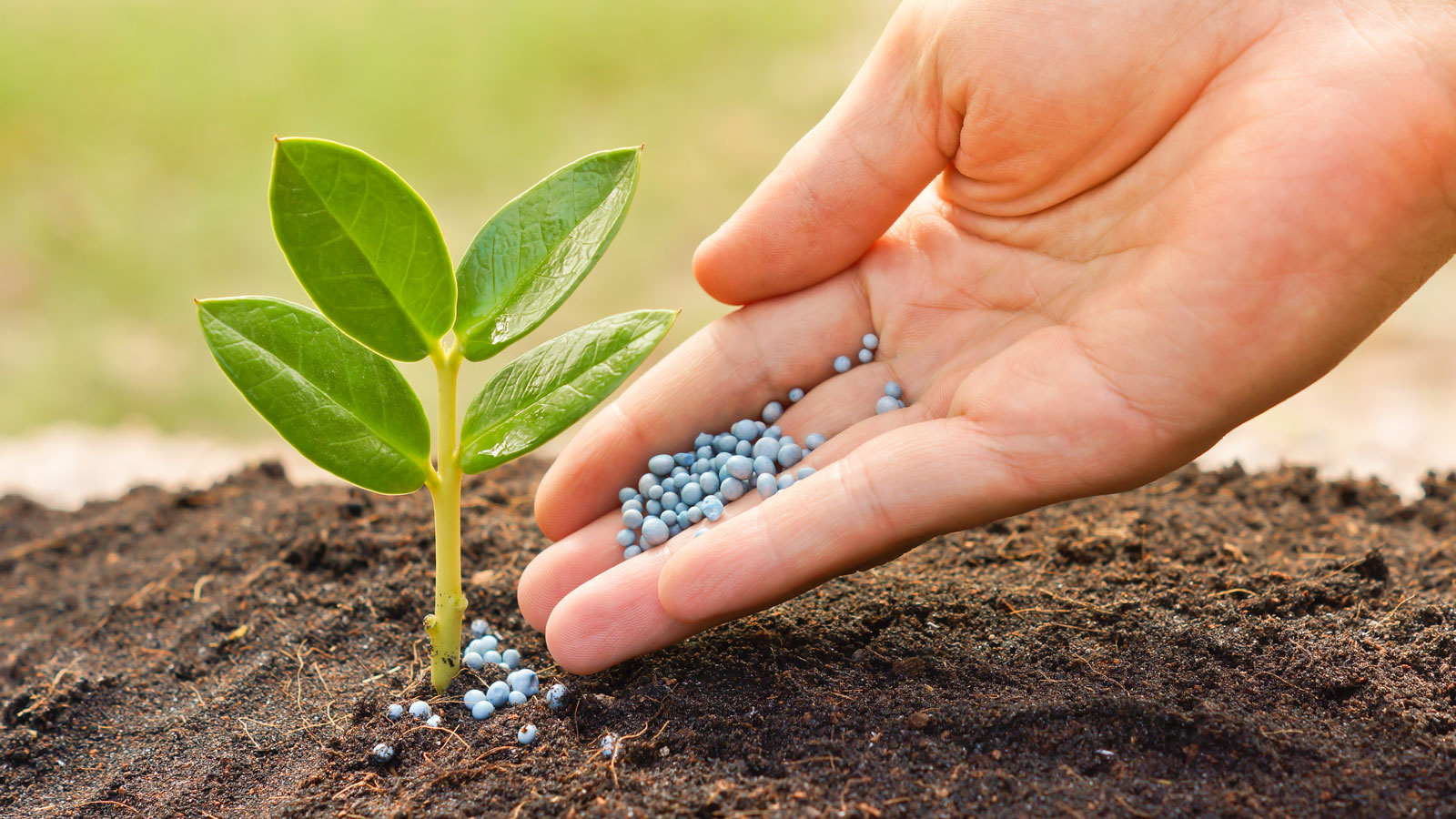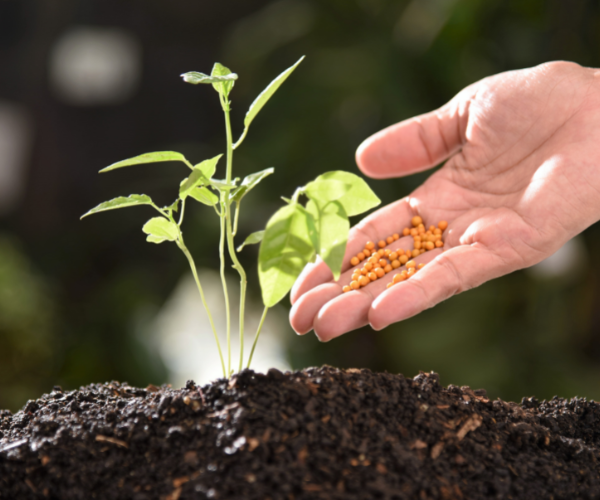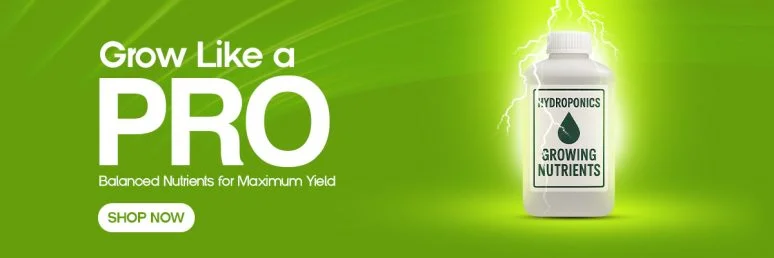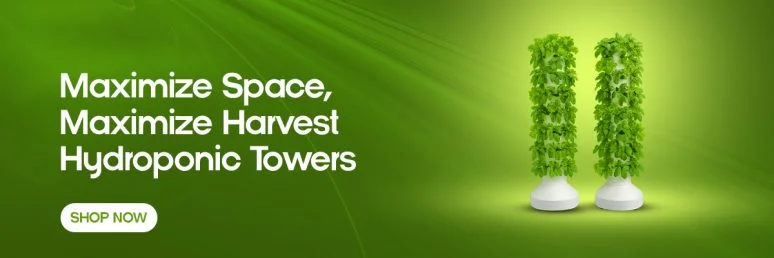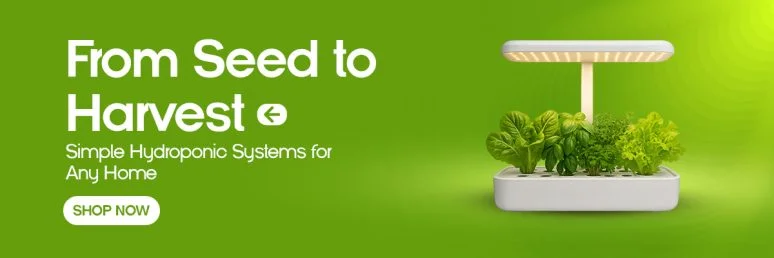What fertilizer Is Used For Hydroponics? Review & Buyer’s Guide
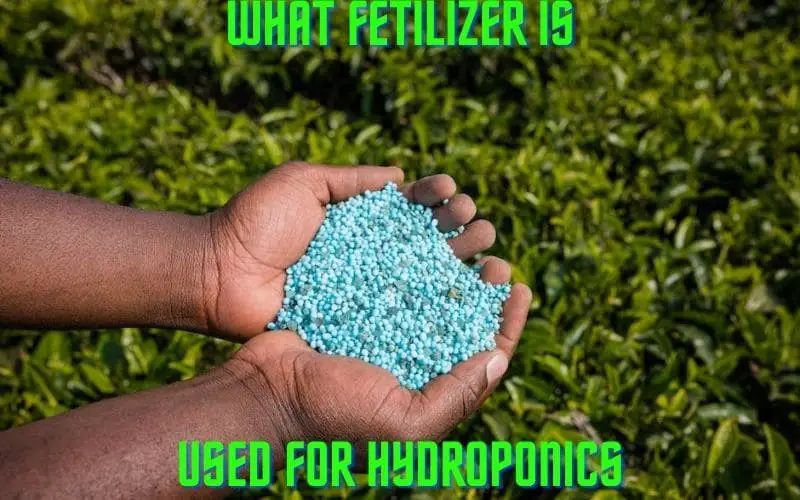
Key Takeaways
- General Hydroponics Flora Series is the top-recommended fertilizer for most hydroponic systems, providing complete nutrition in a customizable three-part formula.
- Hydroponic fertilizers must be completely water-soluble and contain precise ratios of macro and micronutrients that soil-based fertilizers don’t provide.
- Different growth stages require different nutrient ratios—higher nitrogen during vegetative growth and increased phosphorus and potassium during flowering/fruiting.
- EC (electrical conductivity) and pH management are crucial for proper nutrient absorption in hydroponic systems.
- One-part solutions offer convenience for beginners, while advanced growers benefit from the customization of multi-part nutrient systems.
Finding the right fertilizer is make-or-break for your hydroponic garden. Without soil to provide nutrients, your plants rely entirely on what you add to their water. Choose wrong, and you’ll watch your plants struggle despite your best efforts.
I’ve tested dozens of nutrient solutions across various growing systems and plant types, and I’ll guide you through exactly what works, what doesn’t, and why. Whether you’re growing leafy greens, herbs, or fruiting plants, this guide will help you select the perfect hydroponic fertilizer for maximum yields.
Quick Answers At A Glance
For those needing immediate recommendations: General Hydroponics Flora Series is the gold standard for most systems and plants. FoxFarm Trio provides excellent results for flowering plants. If you prefer powdered options, Masterblend 4-18-38 offers tremendous value. Advanced Nutrients pH Perfect line eliminates pH adjustment hassles. Beginners should consider General Hydroponics MaxiGro for its simplicity and effectiveness.
Why Your Hydroponic Plants Need Special Fertilizer
“Fertilizers That Help To Grow Plants …” from www.ugaoo.com and used with no modifications.
Hydroponic plants have different nutritional needs than their soil-grown counterparts. In hydroponics, plants get zero nutrition from their growing medium. Every single mineral, from nitrogen to zinc, must come from your nutrient solution. This makes your fertilizer choice absolutely critical.
Unlike soil growing where plants can forage for nutrients and beneficial microbes assist with uptake, hydroponic plants have only what you provide in their water. Their roots are constantly bathed in the nutrient solution, making uptake efficiency dramatically different. This is why using regular garden fertilizers often leads to deficiencies, lockout problems, and poor growth.
The Critical Difference Between Soil and Hydroponic Fertilizers
The fundamental difference lies in solubility. Hydroponic nutrients must be 100% water-soluble to prevent clogged systems and ensure complete availability to plants. Soil fertilizers often contain insoluble components that break down over time – useless in hydroponics.
Hydroponic formulations also contain precise ratios of both macronutrients and micronutrients. Many soil fertilizers focus primarily on NPK (nitrogen, phosphorus, potassium) and rely on the soil to provide trace elements. In hydroponics, your solution needs everything from calcium and magnesium to molybdenum and boron in perfect balance.
- Hydroponic fertilizers are completely water-soluble to prevent system clogging
- They contain precise ratios of both macro and micronutrients
- They’re formulated for different pH and electrical conductivity parameters
- Many include chelated micronutrients for better absorption
- Some advanced formulations contain buffers to help maintain proper pH
Another key difference is in application method. Soil fertilizers are often designed for periodic application, while hydroponic nutrients are constantly available to plants, requiring different concentration approaches and more frequent monitoring.
Essential Nutrients Your Hydroponic Plants Can’t Live Without
Successful hydroponic growing requires providing all 17 essential plant nutrients. These break down into macronutrients (needed in larger quantities) and micronutrients (needed in trace amounts). Missing even one can stunt growth or cause crop failure.
The primary macronutrients (NPK) drive different aspects of plant development. Nitrogen fuels leafy growth, phosphorus supports root development and flowering, while potassium strengthens cell walls and regulates water use. Secondary macronutrients include calcium, magnesium, and sulfur, which support structural integrity and various metabolic functions.
Micronutrients like iron, manganese, zinc, and copper serve as enzyme cofactors for critical plant processes. Though needed in tiny amounts, deficiencies quickly manifest as yellowing leaves, stunted growth, or deformities. Complete hydroponic nutrients provide the full spectrum in bioavailable form.
Essential Plant Nutrients in Hydroponics
Macronutrients: Nitrogen (N), Phosphorus (P), Potassium (K), Calcium (Ca), Magnesium (Mg), Sulfur (S)
Micronutrients: Iron (Fe), Manganese (Mn), Zinc (Zn), Copper (Cu), Boron (B), Molybdenum (Mo), Chlorine (Cl)
Other elements: Carbon (C), Hydrogen (H), Oxygen (O), Silicon (Si)
While carbon, hydrogen, and oxygen come primarily from water and air, the remaining elements must be supplied through your nutrient solution. Quality hydroponic fertilizers ensure these elements are present in forms your plants can readily absorb.
5 Best Hydroponic Fertilizers For Maximum Growth
“A Complete Guide To Feeding Plants …” from www.gardeningknowhow.com and used with no modifications.
- General Hydroponics Flora Series – Best overall three-part solution
- FoxFarm Nutrient Trio – Best for flowering and fruiting plants
- Masterblend 4-18-38 Complete Kit – Best value powdered option
- Advanced Nutrients Bloom, Micro & Grow – Best pH-buffered option
- General Hydroponics MaxiGro & MaxiBloom – Best for beginners
After testing numerous options across different growing systems, these five consistently deliver exceptional results. Each offers different advantages depending on your growing goals, experience level, and budget constraints.
1. General Hydroponics Flora Series
The Flora Series stands as the industry gold standard for good reason. This three-part system (FloraGro, FloraMicro, and FloraBloom) lets you customize nutrient ratios throughout your plants’ lifecycle. During vegetative growth, you use more FloraGro; during flowering, you increase FloraBloom. This flexibility is why it works exceptionally well for virtually any plant type.
2. FoxFarm Nutrient Trio
FoxFarm’s trio (Grow Big Hydro, Tiger Bloom, and Big Bloom) excels particularly with fruiting and flowering plants. The formulation produces vibrant, aromatic blooms and impressive fruit yields. While slightly more expensive than some options, the results justify the cost for serious growers focused on harvest quality.
3. Masterblend 4-18-38 Complete Combo Kit
For cost-conscious growers, Masterblend offers tremendous value without sacrificing quality. This powdered three-part system includes Masterblend 4-18-38, calcium nitrate, and magnesium sulfate (Epsom salts). The powder format makes it economical for large systems, though it requires more precise measuring than liquid options. Commercial growers often choose this for its consistency and cost-effectiveness at scale.
NPK Ratios: The Foundation of Fertilizer Selection
“The Essential Fertilizer Guide for a …” from primexgardencenter.com and used with no modifications.
Understanding NPK ratios is essential for hydroponic success. These three numbers (like 3-2-1 or 4-18-38) represent the percentage by weight of nitrogen (N), phosphorus (P), and potassium (K) in your fertilizer. Each nutrient drives different aspects of plant development, and the right balance changes throughout your plant’s lifecycle.
Nitrogen primarily fuels vegetative growth – the lush, green foliage that develops before flowering. Phosphorus supports root development, energy transfer within the plant, and flowering/fruiting processes. Potassium regulates numerous metabolic activities, strengthens cell walls, and helps plants resist disease and stress.
The ideal NPK ratio depends entirely on what you’re growing and its current growth stage. Leafy greens like lettuce and spinach thrive with nitrogen-heavy formulas throughout their lifecycle. Fruiting plants like tomatoes and peppers need more balanced nutrition during vegetative growth, then higher phosphorus and potassium during flowering and fruiting.
- Vegetative growth: Higher nitrogen ratio (3-1-2, 2-1-1)
- Flowering/fruiting initiation: Balanced ratio (1-1-1, 2-2-2)
- Fruit/flower development: Higher phosphorus and potassium (1-3-2, 0-5-4)
- Leafy vegetables (entire lifecycle): Nitrogen-focused (3-1-2, 4-1-3)
- Root crops: Phosphorus-focused (1-2-1, 1-3-2)
What Those Numbers Actually Mean
When you see a fertilizer labeled as 4-18-38, this means it contains 4% nitrogen, 18% phosphorus (in the form of P₂O₅), and 38% potassium (as K₂O) by weight. The remaining percentage consists of micronutrients, carriers, and other ingredients. This is why different fertilizers with similar NPK ratios can perform differently – the remaining components and their bioavailability matter tremendously.
Ideal NPK Ratios For Different Growth Stages
During the vegetative stage, most plants benefit from a nitrogen-rich formula (like 3-1-2 or similar) to develop strong stems and lush foliage. As plants transition to flowering, gradually shift toward formulations with higher phosphorus and potassium (like 1-3-4). For continuous harvest plants like herbs or leafy greens that don’t flower for production, maintain a steady nitrogen-focused formula throughout their lifecycle, periodically flushing to prevent salt buildup.
Micronutrients: The Hidden Heroes of Hydroponic Growth
“Fertilizing Indoor and Outdoor Plants …” from www.anythinggroes.com and used with no modifications.
While NPK gets most of the attention, micronutrients often make the difference between mediocre and exceptional harvests. These elements – including iron, manganese, zinc, copper, boron, and molybdenum – are required in tiny amounts but are absolutely essential for plant metabolism. In soil, these are often naturally available, but in hydroponics, you must provide each one. For more information on nutrient regimens, check out the best nutrient regimens for hobby hydroponics.
Quality hydroponic nutrients include a full spectrum of chelated micronutrients. The chelation process binds these minerals to organic compounds, making them more stable in solution and more readily available to plants. This is particularly important for elements like iron, which can quickly become unusable to plants in the wrong form. When comparing fertilizers, look for those specifying “chelated micronutrients” for superior performance.
Why Calcium and Magnesium Supplements Matter
Calcium and magnesium occupy a middle ground between macronutrients and micronutrients and deserve special attention. Calcium strengthens cell walls and facilitates nutrient uptake, while magnesium is essential for chlorophyll production and enzyme activation. Many hydroponic growers supplement with Cal-Mag products even when using complete nutrient solutions.
Calcium deficiency manifests as tip burn, blossom end rot, or stunted new growth – problems that can devastate your harvest. Magnesium deficiency typically appears as interveinal chlorosis (yellowing between leaf veins) starting with older leaves. Both problems are common in hydroponics and can appear even with premium nutrients if your water is too soft or your plants are heavy feeders.
Identifying and Fixing Common Nutrient Deficiencies
Nutrient deficiencies in hydroponics often appear as discoloration, deformities, or unusual growth patterns. Yellowing older leaves typically indicate nitrogen deficiency, while purplish stems may signal phosphorus issues. Potassium deficiency often shows as brown scorching along leaf edges. For micronutrients, iron deficiency appears as yellowing between veins of new growth, while zinc deficiency causes “little leaf” syndrome with stunted leaves.
The key to addressing deficiencies lies in regular system monitoring. Test both pH and EC (electrical conductivity) daily, and adjust your nutrient solution accordingly. Most deficiencies in hydroponics aren’t from lack of nutrients in the solution but from pH drift that prevents proper absorption. Keeping pH between 5.5-6.5 (depending on crop) ensures optimal nutrient availability across the spectrum.
How To Use Hydroponic Fertilizers Correctly
“3 Natural Fertilizers You Already Have …” from livetrends.com and used with no modifications.
Successful hydroponic feeding requires precision, consistency, and regular monitoring. Start with clean water, ideally filtered or treated to remove chlorine and heavy metals. Follow mixing instructions exactly, measuring components by weight rather than volume whenever possible. Always add concentrated nutrients to water, not water to nutrients, to prevent chemical reactions that can render certain elements unavailable.
Measuring and Mixing For Perfect Results
For multi-part nutrients like the Flora Series, always add each component separately, stirring well between additions. Follow the manufacturer’s recommended order – typically micronutrients first, then calcium-containing components, and finally primary nutrients. This prevents precipitation and ensures all elements remain available. For precise measurements, invest in calibrated syringes or pipettes for liquid concentrates and a digital scale accurate to 0.1g for powdered nutrients.
Adjusting EC and pH Levels
Optimal EC Ranges by Plant Type
Leafy Greens: 0.8-1.2 mS/cm
Herbs: 1.0-1.6 mS/cm
Fruiting Vegetables: 1.8-3.0 mS/cm
Strawberries: 1.4-1.8 mS/cm
Flowering Ornamentals: 1.2-1.5 mS/cm
Electrical conductivity (EC) measures the total dissolved solids in your nutrient solution and indicates overall nutrient concentration. Higher EC means more concentrated nutrients, which can benefit heavy feeders but damage sensitive plants. Start with the lower end of the recommended range and increase gradually while monitoring plant response.
pH dramatically affects nutrient availability. In hydroponics, maintain pH between 5.5-6.5, with 5.8-6.2 being ideal for most crops. Below 5.5, micronutrients become too available and can reach toxic levels. Above 6.5, calcium, phosphorus, and several micronutrients become increasingly locked out.
Test pH after mixing nutrients, as most fertilizers will change your water’s pH. Adjust using pH Up (potassium hydroxide) or pH Down (phosphoric acid) solutions specifically designed for hydroponics. Add these adjusters in small increments, stirring thoroughly and retesting before adding more.
Creating a Feeding Schedule That Works
Develop a feeding schedule based on your specific plants, growth stage, and environmental conditions. Start with the manufacturer’s recommendations, then adjust based on plant response. Many growers alternate between regular strength feeding and lower-concentration “maintenance” feeding, with periodic system flushes using plain pH-adjusted water to prevent salt buildup. Document your feeding program and plant responses to refine your approach over successive growing cycles.
Common Hydroponic Fertilizer Mistakes That Kill Plants
Even experienced growers make nutrient management errors. The most common mistake is following feeding charts too rigidly without considering environmental conditions. Hot, bright conditions increase water transpiration, concentrating nutrients in your reservoir. Cooler, cloudy conditions reduce plant uptake, potentially leading to toxicity if you continue with aggressive feeding. For more insights, check out the best nutrient regimens for hydroponics.
Warning Signs of Nutrient Problems
Too Much Fertilizer: Leaf tip burn, wilting despite adequate water, dark green leaves that appear almost blue, stunted growth
Too Little Fertilizer: Pale leaves, slow growth, thin stems, small leaf size, early leaf drop
pH Problems: Interveinal chlorosis, nutrient deficiency symptoms despite adequate feeding, brittle leaves
Many growers make the mistake of adding more nutrients when plants show stress, when often the opposite approach is needed. Plant problems frequently stem from nutrient imbalance or lockout rather than deficiency. When troubleshooting, first check environmental conditions and system function, then measure pH and EC before adjusting your nutrient regime.
Another common error is mixing incompatible supplements or additives. Some compounds can react with each other, forming precipitates that clog systems and make nutrients unavailable. Always research compatibility before combining products from different manufacturers, and add supplements individually with thorough mixing between additions.
Overfeeding: The Silent Plant Killer
Overfeeding is far more common than underfeeding in hydroponics. The misconception that “more is better” leads many growers to exceed recommended concentrations, causing nutrient burn and salt buildup. Signs of overfeeding include leaf tip browning, abnormally dark foliage, and stunted growth despite otherwise ideal conditions. When plants receive too many nutrients, they expend energy trying to regulate internal osmotic pressure instead of producing foliage and fruits.
If you suspect overfeeding, immediately replace your nutrient solution with quarter-strength nutrients or plain pH-adjusted water. Monitor plant recovery and gradually increase concentration as plants show improvement. Remember that environmental stress makes plants more sensitive to nutrient concentration – during heat waves or low humidity, consider reducing nutrient strength by 25-50%.
Using Soil Fertilizers in Hydroponic Systems
Using standard garden fertilizers in hydroponics is a recipe for disaster. Soil fertilizers often contain insoluble components that can clog pumps, block irrigation lines, and create dead zones in your growing media. They frequently lack critical micronutrients, assuming soil will provide these elements. Many also contain urea nitrogen, which requires soil bacteria for conversion to plant-available forms – these bacteria are absent in most hydroponic systems, leading to nitrogen deficiency despite high nitrogen content on the label.
Buying Guide: How To Choose The Right Hydroponic Fertilizer
“Homemade Fertilizer for Plants: 10 Best …” from lomi.com and used with no modifications.
Select your hydroponic fertilizer based on your specific growing needs, experience level, and system type. For beginners, one-part solutions offer simplicity and reasonable results. As you gain experience, three-part systems provide greater customization and typically produce superior harvests. Consider your water source as well – hard water may require formulations with less calcium and magnesium, while soft water users often need additional Cal-Mag supplements. For automated systems with infrequent reservoir changes, look for nutrients specifically formulated for recirculating systems, with minimal precipitation and longer solution stability.
Match The Fertilizer To Your Plant Type
Different plants have dramatically different nutrient requirements. Leafy greens like lettuce, spinach, and kale thrive with nitrogen-rich formulas (3-1-2 ratio), while fruiting plants like tomatoes and peppers need higher phosphorus and potassium during flowering and fruiting stages (1-3-4 ratio). Herbs generally prefer moderate nutrient levels with balanced NPK. Match your fertilizer choice to your specific crops for best results.
Consider Your Experience Level
If you’re new to hydroponics, start with simpler nutrient systems. One-part solutions like MaxiGro or Dyna-Gro provide good results with minimal complexity. They may not offer the same customization as multi-part systems, but they significantly reduce the chances of mixing errors that can damage or kill your plants.
Intermediate growers should consider three-part systems like General Hydroponics Flora Series or FoxFarm Trio, which offer more control while still providing clear mixing instructions. These systems allow you to adjust nutrient ratios as plants progress through different growth stages, maximizing yields without overwhelming complexity.
Advanced growers often create custom nutrient profiles using individual components or professional-grade base nutrients with specific additives for each growth phase. This approach requires significant knowledge but allows for precise nutrition tailored to specific genetics and growing conditions.
- Beginners: Choose one-part solutions with straightforward feeding schedules
- Intermediate: Three-part systems with adjustable ratios
- Advanced: Custom formulations or professional-grade nutrient lines
- Commercial: Consider bulk powdered nutrients for cost efficiency
- All levels: Invest in quality pH and EC meters for monitoring
Price vs. Quality: What’s Worth Paying For
While premium nutrients cost more initially, they often deliver superior results that justify the investment. Cheaper fertilizers may lack chelated micronutrients, use lower-quality source materials, or contain fillers that contribute to reservoir sludge. That said, you don’t always need the most expensive option. Mid-range products from established manufacturers typically provide excellent value, especially for home growers. Focus on complete nutrition, chelated micronutrients, and formulations designed specifically for hydroponic systems rather than being swayed by marketing claims or specialty additives that promise miracle results. For more information on choosing the right nutrients, check out this guide to hydroponic nutrients.
The Final Verdict: Best Fertilizers For Different Situations
Quick Recommendation Guide
Best Overall: General Hydroponics Flora Series – versatile, reliable, and widely available
Best for Beginners: General Hydroponics MaxiGro and MaxiBloom – simple yet effective
Best for Fruiting Plants: FoxFarm Nutrient Trio – exceptional for heavy-feeding fruiting crops
Best Value: Masterblend 4-18-38 Complete Kit – economical for larger systems
Best pH-Stabilized Option: Advanced Nutrients Bloom, Micro & Grow – reduces pH management
After extensive testing across multiple crops and systems, General Hydroponics Flora Series earns my top recommendation for most hydroponic growers. Its versatility, reliable performance, and widespread availability make it suitable for nearly any situation. The three-part formula lets you tailor nutrition to your specific plants and growing conditions, while detailed feeding charts take the guesswork out of mixing.
For those managing multiple systems or larger operations, Masterblend 4-18-38 offers exceptional value without sacrificing quality. Its powdered format significantly reduces shipping costs and storage space, while its simple three-component system provides complete nutrition for virtually any crop. Commercial growers particularly appreciate its consistency and cost-effectiveness.
If constant pH adjustment is your biggest frustration, consider Advanced Nutrients with their “pH Perfect” technology. While more expensive than other options, the built-in buffering can save considerable time and reduce the risk of pH-induced nutrient lockout, especially valuable for busy growers who can’t monitor systems daily.
Best For Beginners
For those just starting with hydroponics, General Hydroponics MaxiGro and MaxiBloom provide the perfect balance of simplicity and effectiveness. These one-part powdered nutrients dissolve completely, provide all essential elements, and come with clear instructions. Use MaxiGro during vegetative growth and transition to MaxiBloom when plants begin flowering. This straightforward approach eliminates mixing errors while still allowing basic customization between growth stages.
Best For Leafy Greens
Dyna-Gro Foliage-Pro with its 3-1-2 ratio excels with leafy crops like lettuce, spinach, and kale. Its nitrogen-focused formula promotes lush, rapid foliage growth while providing adequate phosphorus and potassium for structural development and metabolic function.
For commercial-scale leafy green production, Masterblend 4-18-38 adjusted to appropriate concentrations delivers excellent results at a fraction of the cost of liquid nutrients. Its high solubility and clean formulation minimize precipitation issues even in NFT or aeroponics systems where clogging presents serious problems.
Best For Fruiting Plants
FoxFarm’s Nutrient Trio consistently produces exceptional results with fruiting crops like tomatoes, peppers, and cucumbers. The specialized formulations support vigorous vegetative growth before transitioning to abundant, high-quality fruit production. The Grow Big Hydro, Tiger Bloom, and Big Bloom combination provides complete nutrition with beneficial additions that enhance flavor, aroma, and nutrient density. For more information on nutrient regimens, check out this guide on hobby hydroponics nutrients.
For extended production cycles, House & Garden’s Aqua Flakes A&B deserves mention for its exceptional performance with long-season fruiting plants. The two-part formulation provides precise nutrition that maintains plant health through multiple fruiting cycles, reducing the common late-season decline seen with some nutrient lines.
Best Budget Option
Masterblend 4-18-38 Complete Kit delivers professional-grade nutrition at remarkably affordable prices. The powdered format dramatically reduces shipping costs, while the simplified three-component system (Masterblend 4-18-38, calcium nitrate, and magnesium sulfate) provides complete nutrition for virtually any crop. A 25-pound kit can make thousands of gallons of nutrient solution, bringing per-gallon costs far below liquid alternatives.
For smaller operations seeking budget-friendly options, General Hydroponics MaxiBloom used as a one-part solution throughout the growing cycle provides acceptable results at minimal cost. While not as optimized as changing formulations between growth stages, this approach can produce good harvests while keeping expenses low for hobbyist growers.
Frequently Asked Questions
After helping hundreds of growers optimize their hydroponic nutrition, I’ve encountered many common questions about fertilizers. Below are answers to the most frequently asked questions that should help clarify key points and improve your growing success.
Can I use regular garden fertilizer for hydroponics?
No, regular garden fertilizers are not suitable for hydroponic systems. They typically contain insoluble components that will clog pumps and irrigation lines while leaving sediment in reservoirs. Many soil fertilizers also use urea nitrogen, which requires soil bacteria to convert into forms plants can use – these bacteria aren’t present in hydroponic systems.
Additionally, garden fertilizers rarely contain the complete micronutrient profile needed for hydroponic growing, assuming that soil will provide these elements. Always use fertilizers specifically formulated for hydroponics that are fully water-soluble and contain all essential macro and micronutrients in their bioavailable forms.
How often should I change my hydroponic nutrient solution?
For most recirculating systems, change your nutrient solution completely every 7-14 days. However, this interval varies based on plant type, growth stage, reservoir size, and environmental conditions. Fast-growing plants, small reservoirs, and warm conditions all necessitate more frequent changes. Monitor EC (electrical conductivity) daily – when it fluctuates significantly despite top-offs, it’s time for a complete change.
Between full changes, maintain solution levels by adding pH-adjusted water (not nutrient solution) to replace what plants consume and what evaporates. This “top-off” approach prevents nutrient concentration from increasing to potentially harmful levels as water evaporates.
Some sophisticated commercial systems employ more complex management approaches, including constant EC monitoring with automated dosing or daily partial replacements rather than complete reservoir changes. These methods can reduce waste and maintain more consistent nutrient availability but require more sophisticated equipment. For more information on nutrient management, consider exploring nutrient regimens for hobby hydroponics.
- Small systems (under 10 gallons): Change every 7 days
- Medium systems (10-50 gallons): Change every 10-14 days
- Large systems (over 50 gallons): Change every 14-21 days
- DWC and Kratky systems: Change when 50% of solution is consumed
- NFT and aeroponic systems: Require more frequent changes due to faster nutrient uptake
Why are my hydroponic plants showing yellow leaves despite using fertilizer?
Yellowing leaves despite regular fertilization typically indicate a nutrient availability problem rather than a deficiency in your solution. The most common culprit is improper pH – when pH drifts above 6.5 or below 5.5, many nutrients become chemically locked out even when present in adequate amounts. Other causes include nutrient imbalances that create antagonistic relationships (excess potassium can block calcium uptake, for example), poor oxygenation reducing root function, or temperature extremes that impair nutrient absorption. Check system pH first, then examine roots for signs of disease or oxygen deprivation before adjusting your nutrient formulation.
Is it better to use organic or synthetic fertilizers for hydroponic systems?
Synthetic nutrients generally perform more reliably in hydroponics. They provide immediately available nutrition in precise ratios, dissolve completely without residue, and maintain stability in solution. Organic hydroponic nutrients, while improving, often contain particulates that can clog systems, rely on microbial breakdown that’s inconsistent in sterile hydroponic environments, and can introduce pathogens. That said, some newer organic formulations specifically designed for hydroponics show promising results, particularly in bioponics systems that intentionally incorporate beneficial microbes. If environmental concerns are paramount, consider hybrid approaches using primarily synthetic base nutrients with organic supplements.
Can I make my own hydroponic fertilizer at home?
Yes, you can create DIY hydroponic nutrients using technical-grade salts like calcium nitrate, potassium phosphate, magnesium sulfate, and various micronutrient compounds. This approach requires careful calculation, precise measurement, and an understanding of chemistry to prevent harmful interactions between components. Many commercial growers and advanced hobbyists use the “Masterblend formula” (Masterblend 4-18-38, calcium nitrate, and Epsom salts) as a base for customization.
For beginners, commercial formulations offer greater safety and reliability. If you’re determined to create your own, start with established recipes from university extensions or research institutions rather than experimenting. Always wear appropriate protective equipment when handling concentrated fertilizer salts, as many can cause skin irritation or respiratory issues if inhaled.
Trees.com offers comprehensive hydroponic nutrient selection guides and tutorials to help you choose the right fertilizer for your specific growing needs. From beginner-friendly one-part solutions to advanced customizable systems, finding the perfect nutrient balance is essential for hydroponic success.

